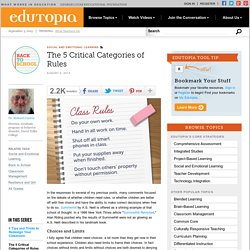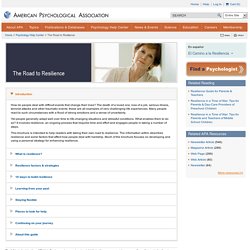

Should students have time to tinker? Educational Technology and Mobile Learning: More Web Tools to Help You Integrate Technology in Class. Edutopia-alexshevrin-valuescloud. Choose the Best Search for Your Information Need. TEACH-LEARN-LEAD - WELCOME. Time + Effort = Excellence! The 5 Critical Categories of Rules. Choices and Limits I fully agree that children need choices, a lot more than they get now in their school experience.

Children also need limits to frame their choices. In fact choices without limits and limits without choices are both doomed to denying children the opportunity of learning how to act responsibly. The extreme of each position is this: Limits without choices: "Do what I say or else. " Neither of these options works in school, but when we combine the two, we have a symbiotic relationship that is designed to teach responsibility: "You cannot hit. Limits Are Rules In school, we express limits as rules. Regardless of whether a school is open and free or traditional, limits or rules are necessary to teach students responsibility.
The categories are meant to be guidelines, not absolutes. Critical Categories Academic: These rules and expectations are related to learning, such as doing homework, class participation, cheating and interrupting others. 8 Pathways to Every Student's Success. Teachers who transform lives understand not only how to teach curriculum, but also how children develop into capable, caring, and engaged adults.

They see beyond quantitative measurements of success to the core abilities that help students live healthy, productive lives. Famous educator Maria Montessori wisely remarked, "The greatest sign of success for a teacher. . . is to be able to say, 'The children are now working as if I did not exist.'" The world has changed dramatically since the early 1900s when Montessori made her mark in education. Yet the same goal remains: scaffolding children toward self-sufficiency. How does this occur today, particularly when test results often seem more important than the development of a child ready to tackle career-life challenges? In a nutshell, it happens when we understand how children and teens successfully mature to adulthood and how we impact their growth in key developmental areas.
Image credit: Marilyn Price-Mitchell, PhD. WeAreTeachers sur Twitter : "MT @TeacherToolkit: 5 Research Based Tips for Providing Students with Meaningful Feedback #edchat #ntchat. What's New in Apps - Recap of July 2015. Results for : PBS LearningMedia. The YOU MATTER Manifesto - Angela Maiers. The Road To Resilience. Information contained in this brochure should not be used as a substitute for professional health and mental health care or consultation.

Individuals who believe they may need or benefit from care should consult a psychologist or other licensed health/mental health professional. Acknowledgments: APA gratefully acknowledges the following contributors to this publication: Lillian Comas-Diaz, PhD, Director, Transcultural Mental Health Institute, Washington, D.C. Suniya S. Salvatore R. H. Karen W. Richard Glenn Tedeschi, PhD, Department of Psychology, University of North Carolina at Charlotte American Psychological Association APA, located in Washington, D.C., is the largest scientific and professional organization representing psychology in the United States, with more than 122,500 researchers, educators, clinicians, consultants and students as its members.
Discovery Health Channel. Grit: The Other 21st Century Skills. Due to the interest of my post The Other 21st Skills, I decided to discuss individually each of the skills or dispositions I proposed that are in addition to the seven survival skills as identified by Tony Wagner.

This post focuses on Grit: Here is Angela Duckwoth’s TED Talk about Grit that provides an overview about the topic. Angela Duckworth developed a scale to measure Grit found at Some of characteristics or dispositions of Grit include: Perseverance and TenacityDeliberate PracticeAbility to Delay GratificationPassion-Driven FocusSelf Control and Self DisciplineLong Term Goal-OrientedStick-to-it-ness Under Difficult ConditionsConsistency of Effort So how can Grit be taught or facilitated?
Awareness of grit can be brought more into conscious by first, teaching learners about grit and then by helping them reflect on their degree and level of grit. Grit can be reinforced though provide emotionally and intellectual support for grit-related behaviors.